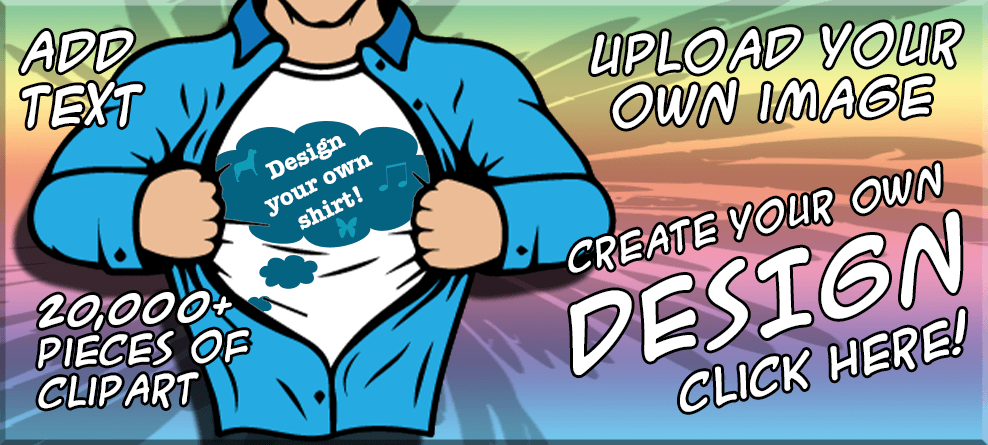Custom Shirts
If you are looking for custom shirts in the Indianapolis area, A+ Images has you covered! We can create a variety of custom designs for your apparel and sign needs. We accomplish this using DTG, screen printing, embroidery, rhinestones, vinyl, and sublimation. If you don’t know what method is best for you project, check out our service pages for more information.
- individuals
- businesses
- bridal/bachelor/bachelorette parties,
- family reunions
- special events
- birthdays
- clubs
- organizations
- anniversaries
- weddings
- schools
- in memory of/funerals
- and more.
Our sign products are great for promotions, trade shows, branding, gifts, advertisements, and more.
If you are looking for custom teacher/school or Kiwanis shirts, click on the appropriate button below to view sample designs and get a quote:
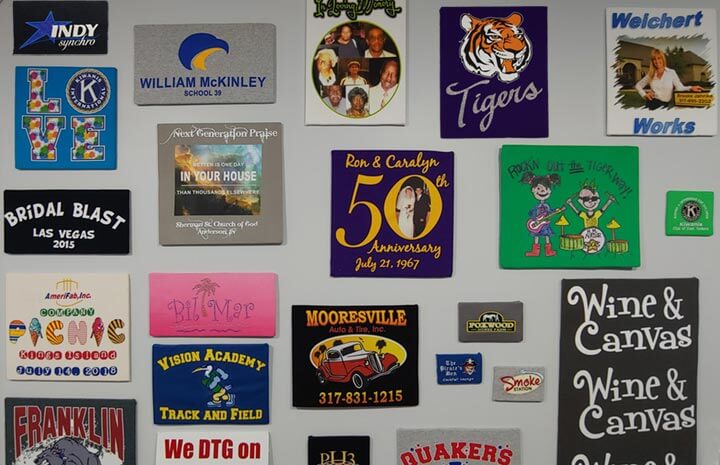
A variety of samples on display in our office.
For all other custom shirt or sign projects, keep reading.
The information below is designed to explain to you what we need from you (in terms of artwork) to get good print results, as well as what we can and can’t print legally.
Information Needed for a Quote
Prior to contacting us for a quote, make sure you have all the necessary information for us to generate a quote. If you are familiar with printing and are clear on what you want, you can go straight to our price charts to get pricing. Pricing on those charts is for decorating only, and does not include garment pricing, or any artwork charges (if applicable). Apparel pricing can change weekly. Contact us to get a quote on blank apparel.
If you don’t know what print method(s) are required for your apparel project, the following information is needed:
- Garment style(s)
- Sizes
- Colors
- Quantities
- Print Locations
- Image sizes
- Number of colors in an image
- Sending copies of the art is highly recommended
Asking, “I need 10 t-shirts printed, how much are they?” isn’t going to get you an answer. If you say something like, “I need 10 G200 shirts in black: 2 M, 4 L, 2 XL, 2 2XL. The left chest has a 3”x3” four-color logo. The back has a 12” x 10” white logo. I have vector artwork. How much are they?” we can get you an exact quote.
Garment styles, colors, and sizes can be found by searching the online catalogs from our main suppliers: alphabroder or Sanmar. When listing colors, please list colors found on the product websites as the manufacturer lists them. For instance, using the G200, don’t ask for “grey” shirts. Gildan offers 5 different greys: Ash Grey, Ice Grey, Sport Grey, Charcoal, & Dark Heather. Please specify which one you want exactly. We cannot get accurate pricing or see if the items are in stock without this detailed information.
When referring to print locations such as left or right chest/sleeve prints, they are listed from the point of view of you wearing the shirt looking at your own shirt. See the illustration for more details.
For sign projects, we at least need to know:
- How many you need
- What material you want (wall decals, banners, stickers, etc.)
- How big you want each image
- Use (weekend sale, tradeshow, indoor/outdoor, etc.)
- Sending a copy of the artwork is highly recommended.
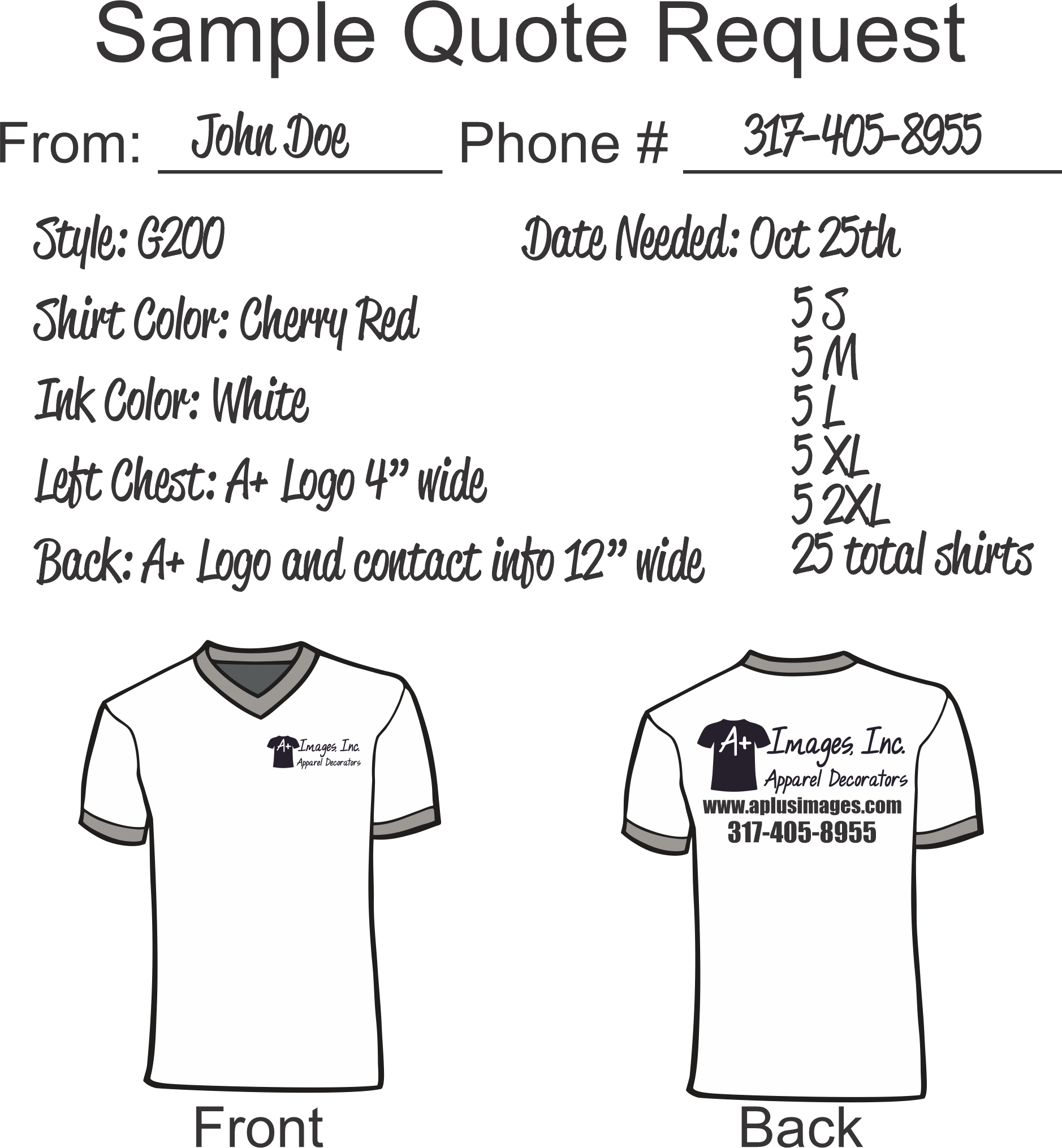
A sample of a form that clearly describes what you want to order.

The above sample shows the correct names for design placement locations.
General Artwork and Legal Guidelines
Each decorating method has its own file requirements. Some processes require vector images. For others, raster images work fine. Review each service page to see what is needed for the decorating method you wish to use. Regardless of your project, below we list some basic information about artwork, along with our polices on reproducing it.
Vector Graphics vs Raster Images
Vector graphics are graphic computer images defined in terms of 2D points and are connected by lines and curves to form shapes or objects. Common file formats include .eps, .svg, .pdf, .ai (Adobe Illustrator), and .cdr (Corel Draw). We use both Corel Draw and Adobe Illustrator to create vector graphics. Generally speaking, vector art is ideal when creating company logos/text/sports team logos and other non-photo-realistic graphics, . It is also scalable without a loss in quality. You can create an image 2” wide that prints well on small promotional products such as pens and t-shirts, but can easily enlarge it to print on banners and billboards.
Raster images (commonly referred to as bitmap images) are computer graphics made from a dot matrix data structure that represents a grid of pixels, with each pixel’s color determined by a number of bits. Common file types include .jpg, .png, .gif, .bmp, .psd (Adobe Photoshop) and some .pdf files. In the print world, these types of graphics are mainly useful when dealing with photographs.
We HIGHLY recommend creating non-photographic art with vector art software. Vector art is useful for printing custom shirts and signs. You easily save the image in raster form (for use on a website) if needed. On the contrary, if you create a logo in Photoshop, but vector artwork is required for your project, it will need to be remade. Saving a Photoshop file as a .eps file is NOT the same as creating a file in Illustrator or Corel Draw and saving it as a .eps file. For more details, here is an excellent article on vector vs raster images.
Resolution
While you can set a resolution to any number in a big range of numbers (limits vary by program), two are commonly used: 72 and 300.
72 dpi images are considered low-resolution and are ideal for websites. Their small file size helps images load faster. They are not being displayed in a massive format, so they don’t require lots of detail.
300 dpi images are considered high-resolution and are ideal for printing. Files tend to be bigger and have more detail. They don’t work well on websites because they take so long to load and frustrate users. Most printing companies recommend or require native 300 dpi images to provide good printed artwork.
For more information on dpi, review these articles: Article 1 and Article 2.
Canvas Size vs Image Size
One of the most common issues we see is a file made without realizing the importance and difference of canvas size and image size. When designing in vector software, it isn’t a huge issue as the image can be resized without losing quality. However, for those that use Photoshop (which isn’t the right program for most design work), the difference can be huge.
For this scenario, we’ll pretend you are using Photoshop. Say you want to draw a smiley face that is 10” x 10”. The proper way to do it is to make your canvas 10” x 10” at 300 dpi, use a transparent background, and draw your smiley face to touch all for sides (but not all four corners). However, most people only make the image a few inches in size and leave a ton of blank space around the image. Many designers argue that it is a 10” x 10” image at 300 dpi. In reality, it is a much smaller image, at a lower resolution.
Not following? Take regular piece of paper. It is 8.5” x 11”. That is your canvas size. Now, draw a 3-inch-tall oval in the middle. That is your image size. How big is your graphic? 8.5” x 11” or about 2” x 3”? If you said 2” x 3”, you are correct! Now, apply this concept to your canvas and image size in Photoshop and you’ll be all set! If you want an image 8.5” x 11”, make you canvas 8.5” x 11” and fill every bit of that space.
To test this concept, when you are done with your artwork, go to: Edit>Trim>Based On Transparent Pixels and check all four boxes in the Trim Away section. If you did it right, nothing will change. If your canvas shrinks after clicking OK, your canvas was much bigger than your image, and your image probably wasn’t as big as you wanted it to be. You must have a transparent background for this to work. Using any other color background or having other images in the canvas will result in this test to not work as planned.
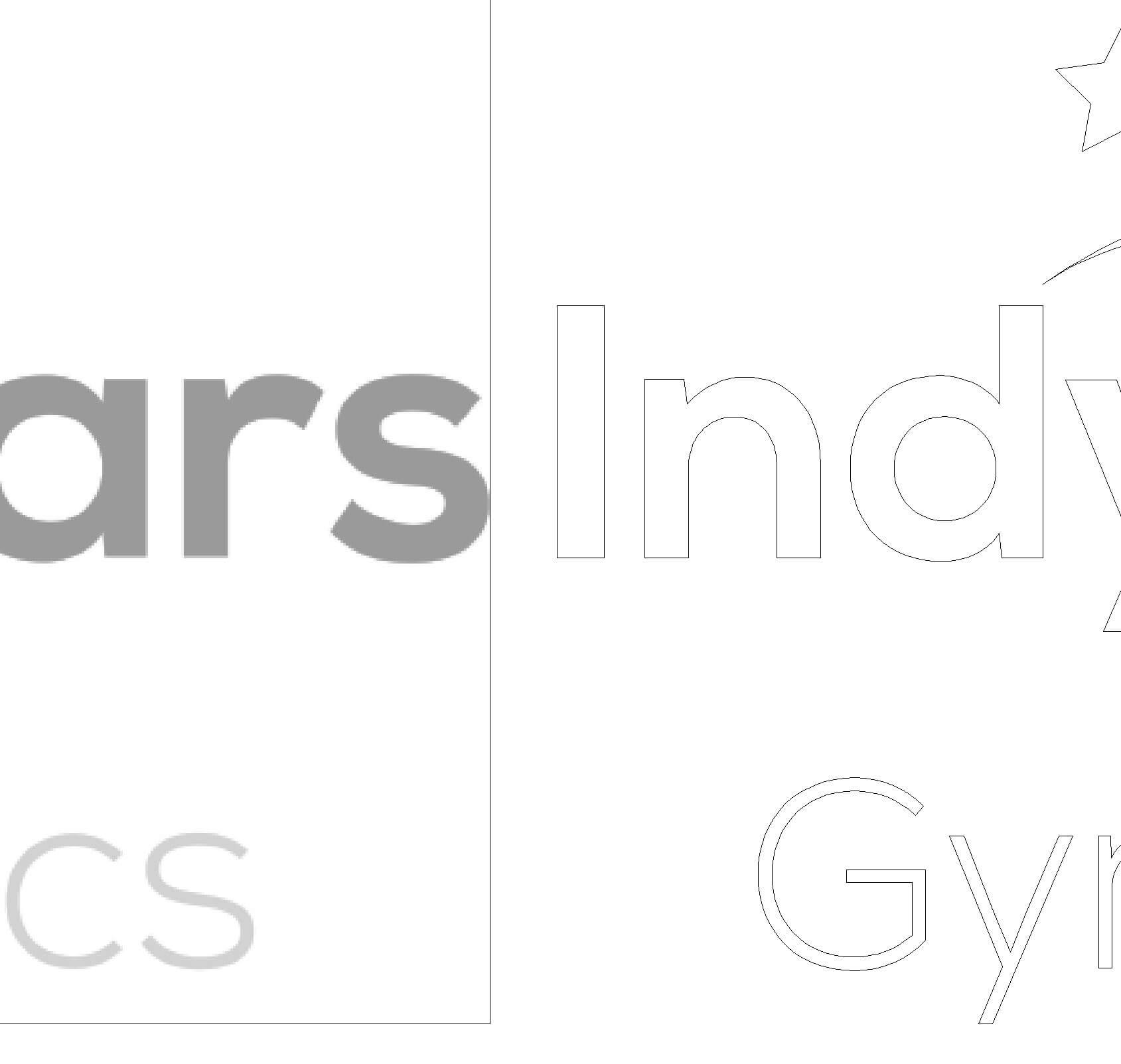
Left: Raster image; Right: Vector image
CMYK vs RGB
Generally speaking, CMYK is for printing (paper, photographs, signs, etc.), and RGB is for displays (website, TV, phone apps, etc.) RGB has a broader color spectrum than CMYK. If you design something in RGB mode using a color outside of the CMYK spectrum, computer software (RIP software) tries to convert it to a CMYK color. Sometimes it works well, other times it doesn’t. With our DTG printing, the difference can be quite noticeable.
CMYK stands for Cyan/Magenta/Yellow/Black. When the colors are combined, they form black. These are the colors of the ink cartridges found in printers. Newer technology has expanded the ability to offer other colors along with stand CYMK colors, such as “light” versions of each color, and in some cases, Red, Green or Orange. This creates a larger color spectrum, but still isn’t as large as the RGB spectrum.
RGB stands for Red/Green/Blue. When the colors are all combined, they form white. Displays use light to show images, while printers do not.
It is important that when you design artwork, you set your color space correctly at the beginning. Otherwise, the software converts the colors and the results may not be what you are looking for. For a more detailed look at CYMK vs RGB, we recommend reading this article.
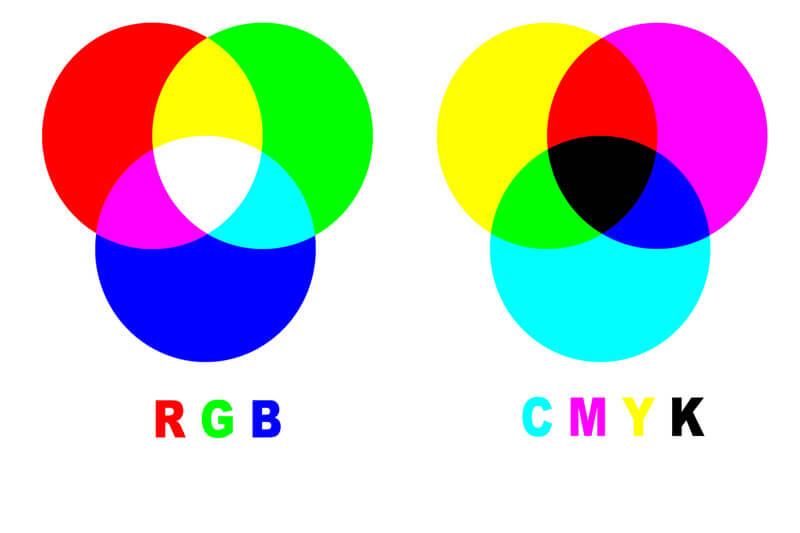
RGB vs CMYK color spectrums
Too busy to read everything? Here is a basic guideline for everything mentioned above: If creating artwork for websites/TV/phone apps, use 72 dpi RGB raster images. If creating artwork for printing, use 300 dpi CMYK (vector when possible) images. If you can’t use vector software to make your graphics, make sure you make your canvas the size you want the image to be. If you want to make a 3’ x 6’ banner, a canvas size of 37” x 73” (for bleeds) at 300 dpi is required. Don’t make a 9” x 18” 72 dpi image in Photoshop and then blow it up to 6’ wide for printing. It will look bad.
Legal Use of Artwork and Copyright Laws
You read everything above and are ready to create the perfect graphic for printing, right? Great, but don’t stop reading yet. We have some legal issues to mention.
First, we are EXTREMELY strict regarding the legal use of artwork. We will not reproduce copyrighted/trademarked/licensed material without explicit written consent from the design/property owner. In most cases, this permission is not easily obtainable. This includes (but is not limited to): professional sports organizations and team names/logos, collegiate teams/logos, characters from movie/tv/books/comics, etc., Greek fraternities/sororities, and companies/brand names. Using a celebrity’s likeness also falls into this category.
Additionally, most files downloaded from the internet are not legal to use. Some websites do allow for commercial use of images (e.g. pixabay.com) or will sell licenses to reproduce images (e.g. istockphoto.com, canstockphoto.com, shutterstock.com, dreamstime.com, etc.). Images like this are normally high-quality and ready for printing. When purchasing such images, make sure you buy the correct license type and file size/format necessary for your project. If you have questions about what to buy, contact us. Images taken from search engine results, websites like Pinterest, and images with watermarks will not be reproduced without owner consent.
You may be required to complete an artwork certification form prior to us beginning production on your order. This form says you have the rights to reproduce the artwork in question and are legally responsible for any legal action taken as a result of the reproduction of any infringing artwork. This should not be taken lightly and can cost thousands (or even millions) of dollars in legal fees and judgements.
Think of it this way: If you created something and put it on you own website, and someone else downloaded that image and printed it on shirts they sold to make millions of dollars, what would you do? Chances are, suing them would be the answer. We don’t want this to happen to us (or you). When you play by the rules and create your own artwork…the possibilities are endless!
If you wonder why companies do this, there are two main reasons: they have a monetary incentive and they want to control the use of their logo through branding standards. The licensing section further down addresses this more.
Common Misconceptions
Public Domain: You may be thinking, if it’s on the internet, it is “public domain” and legal to use. WRONG! Public domain applies once the copyright has expired, or when the creator of artwork specifically makes their work part of the public domain. Google even writes directly under each image in a search result “Images may be subject to copyright”. That picture of a beach you found (and want to print a poster from using it) was taken by someone. Either that person or the company they work for owns the legal rights to that image. Their permission is required to reproduce it.
Fair Use: Many people think downloading an image from a search result for printing on a t-shirt is “fair use”. WRONG! The Fair Use Act was created to balance the interest of copyright holders with public interest. This allows people to review copyrighted work (such as a book or movie review) or report the news (displaying a company logo on a television screen during a newscast) without affecting free speech rights. If we were to print the image on a shirt and sell it to you (regardless of your use for it later), it is no longer “fair use”. We would be profiting off someone else’s work, while they receive no benefit. This is considered infringement, and why we don’t do it.
No © Symbol: You found an image online and it doesn’t have the copyright symbol so it’s legal use, right? WRONG! A copyright symbol is not required to be displayed to make a work of art receive copyright protections. The copyright symbol is generally there to identify the copyright holder. This makes it easier for someone to figure out who created the design in question, so they can be contacted about licensing or reproduction questions. When someone takes a photo, draws a picture, or creates a design on a computer, that work of art is instantly copyrighted by the artist. Registering a copyright with the copyright office can provide additional protections.
10% rule: You may think it’s okay to download a copyrighted image and change 10% (or whatever rumored number you heard) and avoid copyright infringement. WRONG! The truth is, there is no magic number of change that dissolves copyright protection on a work of art. Copyright law refers to work based on the work of someone else as “derivative work” and the original artwork creator’s explicit permission is required. Taking the Mickey Mouse logo and changing the color of shorts to green, the shoes to blue, and shortening the tail and selling it as “Nicky Mouse” is just as illegal as copying the original design.
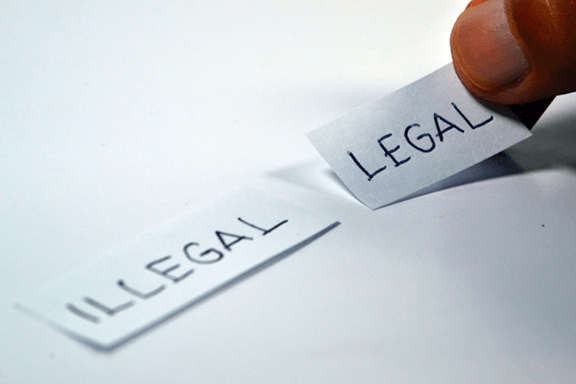

A sample disclaimer in a Google image search result.
Trademark law
While not as common of an issue as copyright violations, trademark law still plays a role in what we will (or more likely, will not) reproduce. Trademarks are words, phrases or logos that identify the source of goods or services. Specifically, trademarks help correlate a product to a company and protect consumers. For instance, some examples are “Just Do It” by Nike, the Google logo, and “America Runs on Dunkin” by Dunkin’ Donuts. Trademarks mainly come into play when text is involved in a design. There are 7 major factors for identifying trademark infringement. The easiest one is whether or not the design is “likely to deceive”. Would the average person see your design or product and think it was the work of another company? If so, you could be liable for infringement. Furthermore, this article does a great job explaining trademark infringement.
Licensing
Licensed designs are copyrighted and/or trademarked designs that a company allows others to reproduce for a financial incentive. Many major brands license their designs to companies around the world that specialize in producing those products. You have likely experienced this daily in any store you go to. Examples range from Nestle factories making frozen California Pizza Kitchen pizzas to Tervis mugs with your favorite Star Wars character on them to Reebok printing UFC apparel. We are licensed by Kiwanis International to reproduce their word-mark and slogans.
Licensing serves two purposes. First, it allows creators to earn money from others that sell a product incorporating their design. This allows people to make money from their work without having to invest in equipment and inventory to produce their product in fields they don’t want to be in or aren’t familiar with. Second, it provides clear rules (using branding guides) on what can and cannot be done so the brand isn’t damaged. For instance, you could get licensed to produce the IU logo on shirts. However, it doesn’t give you the right to change the color scheme, distort the logo, use it in a derogatory way, or stick another logo on top of it.
Many of the popular designs people want replicated are licensed, trademarked, and/or copyrighted. Professional sports organizations and team names/logos, collegiate teams/logos, characters from movie/tv/books/comics, etc., Greek fraternities/sororities, and companies/brand names (unless we are doing for directly for that company) are all examples of things we won’t print. No, you might not want to pay $40 for a t-shirt at the mall with your favorite team on it, but there is a reason for that high price. The money goes to the store that is selling it, the people that made the garment, and the team that owns the rights to the logo.
Real Life Lawsuit Examples
The following links are to stories involving copyright/trademark infringement. Give them a read to see how serious (and expensive) copyright/trademark infringement can be!
- 1. https://99designs.com/blog/tips/5-famous-copyright-infringement-cases/
- 2. https://thetmca.com/superman-superdad-and-the-limits-of-a-trademark-parody-defense/
- 3. https://fstoppers.com/business/indiana-photographer-sues-over-copyright-infringement-309027
- 4. https://www.tmz.com/2018/04/04/kylie-kendall-jenner-tupac-t-shirts-lawsuit-settled/
- 5. https://www.contentfac.com/copyright-infringement-penalties-are-scary/
- 6. https://www.michaelessek.com/parody-fair-use-mash-ups-copyright-info-t-shirt-designers/
- 7. https://www.shinyhappyworld.com/2014/05/disney-crafting-lawsuits-copyright-infringement.html
- 8. https://www.liquidlitigation.com/blog/nfls-legal-blitz-protect-trademark/
- 9. https://www.baltimoresun.com/news/bs-xpm-2001-01-20-0101200115-story.html
- 10. http://www.ipwatchdog.com/2018/01/27/grumpy-cat-wins-copyright-trademark-infringement/id=92904/
Disclaimer
We are not lawyers, and this should not be considered legal advice. This website (specifically the content and links provided above) are simply for educational purposes and for you to have a clear understanding of our policies. This information should not take the place of legal advice from your attorney. Every effort has been made to ensure that the content provided on this website is accurate and helpful for our customers at publishing time. A+ Images assumes no liability for losses or damages due to the information provided on this site. You are responsible for your own choices, actions, and results. Consult your attorney for your specific copyright/trademark/licensing questions and needs.
Ready to Order?
Now that you know what we will and will not print, along with what we need from you to start an order, you can begin to turn your vision into a finished product! You can submit your order via email or setup an appointment at our office to discuss it. We do not take orders over the phone.
You can design artwork using your own software, a third-party graphic designer (make sure you give them the file requirements found on this site), have us do it, or click the image below to start designing online. Additional print-ready (and free) artwork can be found here.
Thank you for taking the time to understand our policies and requirements. We look forward to working with you on your next custom shirt or sign project!

